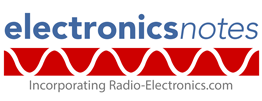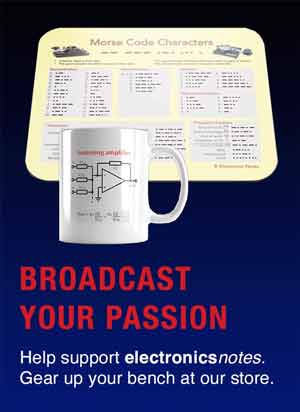Home » Component data » Transistor data » this page
BC849 SMD Transistor Data
Key transistor data for the BC849 NPN general purpose transistor including key electrical parameters, pinout, package type and many other key transistor datasheet details.
The BC849 is a general purpose transistor housed within an SOT23 surface mount, SMD package. Some datasheets also describe this device as being for switching and general purpose applications.
Key datasheet details and performance parameters for the BC849 transistor.
| nnn transistor datasheet parameters & data |
|
|---|---|
| Parameters | Details |
| Transistor type | NPN general purpose |
| Package type | SOT23 |
| Transistor SMD Ident** | |
| VCBO max (V) | 30 |
| VCEO max (V) | 30 |
| VEBOmax (V) | 5 |
| IC max (mA) | 100 |
| TJ Max °C | 150 |
| PTOT mW | 250 |
| fT min (MHz) | 100 |
| COB | 3.5pF typical |
| hfe | see below |
| IC for hfe | |
| Similar / equivalents | |
Outline & pinout:
Explanation of transistor parameters
| Parameter | Explanation |
|---|---|
| VCBO Max | Maximum collector-base voltage with emitter open circuit . |
| VCEO Max | Maximum collector-emitter voltage with base open circuit. |
| VEBO Max | Maximum emitter-base voltage with collector open circuit. |
| VCEsat (included where applicable) | The voltage drop across the collector-emitter when the transistor is fully saturated (acting as a closed switch). |
| IC Max | Maximum collector current. |
| Parameter | Explanation |
|---|---|
| TJ | Maximum junction temperature. |
| PTOT Max | Maximum device dissipation normally in free air at 25°C unless other conditions indicated. |
| fT Min | Minimum cutoff frequency at which the current gain in a common emitter circuit falls to unity. |
| COB Max | Maximum collector capacitane, normally measured with emitter open circuit. |
| hFE | DC current gain for HFE at IC. [Note hfe is the small signal gain and although this may be slightly different, the transistor current gain will vary considerably from ne transistor to the next of the same type.] |
| PTOT Max | Maximum device dissipation normally in free air at 25°C unless other conditions indicated. |
These are the main transistor parameters that have been included in our list. There are others, but these help quantify the main elements of the performance of the transistor.
Please note, that the data given is the best estimate we can give within a tabulated summary of this nature. Parameters also vary between manufacturers. Electronics Notes cannot accept any responsibility for errors, inaccuracies, etc, although we do endevaour to ensure the data is as accurate as possible.
Notes and supplementary information
• Availability & sources
The BC849 is available from a number of stockists and electronic component distributors many of which are given in the table below.
BC849 Component Distributor, Stock and Pricing
• hFE for variants
The BC849 has three variants according to the gain, A: 110 - 220, B: 200 - 450, C: 420 - 800.
The suffixes A, B or C are added to the overall part number so that the required selection can be made.
• Noise performance
Although the BC849 is not designated a low noise transistor it offers a relatively good level of performance.
The noise performance is specified as being a 4.0 dB maximum with a VCE of 5V collector current Ic of 200µA, RG of 2kΩ and f = 10 Hz to 15.7 kHz.
• Notable features
The BC849 and its variants (BC849B, BC849C) are distinguished by:
General Purpose Design: They are explicitly marketed for general purpose switching and amplification, making them a versatile component for countless circuit designs.
Small Form Factor: The SOT23 plastic package is a widely used and industry-standard miniature surface-mount package, suitable for dense and automated board assembly.
High hFE Classification: The BC849 is available in high-gain groups (B and C). For instance, the BC849C typically offers an hFE range of 420 to 800, providing significant current amplification.
Low-Noise Capability: While the related BC850 is specifically designated as a low-noise type, the BC849 is also considered a low-noise transistor in the BC846-BC850 series, particularly in its higher gain variants, making it suitable for pre-amplifier stages.
AEC-Q101 Qualification: Some manufacturers offer an AEC-Q101 qualified version, meaning it is certified for use in harsh automotive environments.
• Typical applications summary
| Application Category | Typical Use Case | BC849 Feature Utilized |
|---|---|---|
| Signal Amplification | Preamplifiers, audio stages, small-signal RF circuits | The high hFE (current gain) and low-noise properties, especially in 'C' variants, are used to boost weak signals. |
| Digital / Logic Interfacing | Driving small relays, low-power indicator LEDs, or buzzers from microcontrollers (MCUs) | Functions as an efficient low-voltage switch to convert a low-current logic signal into a higher-current output (up to 100mA). |
| Coupling and Buffering | Providing signal isolation and impedance matching between different circuit blocks | Its general-purpose BJT characteristics ensure signal integrity and proper current delivery between stages. |
| Analogue Circuit Building Blocks | Current mirror circuits and basic operational amplifier/differential amplifier inputs | The standard and predictable silicon BJT behaviour is ideal for implementing precision analogue functions in a compact SOT23 footprint. |
 Written by Ian Poole .
Written by Ian Poole .
Experienced electronics engineer and author.
Return to Component Data menu . . .





